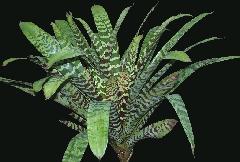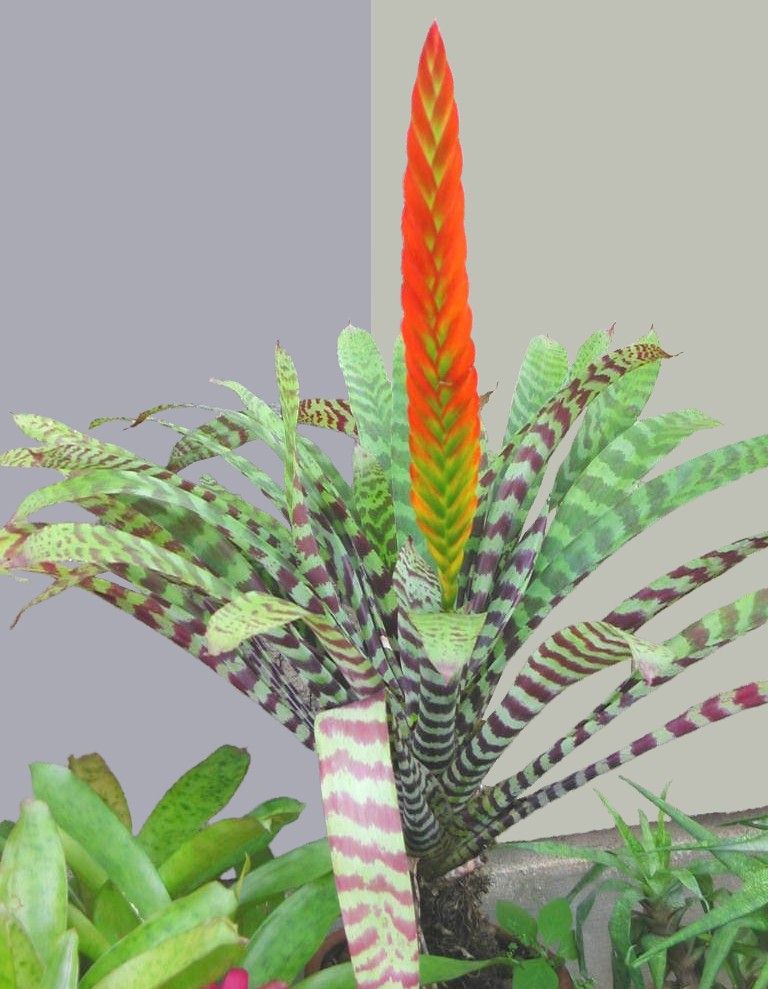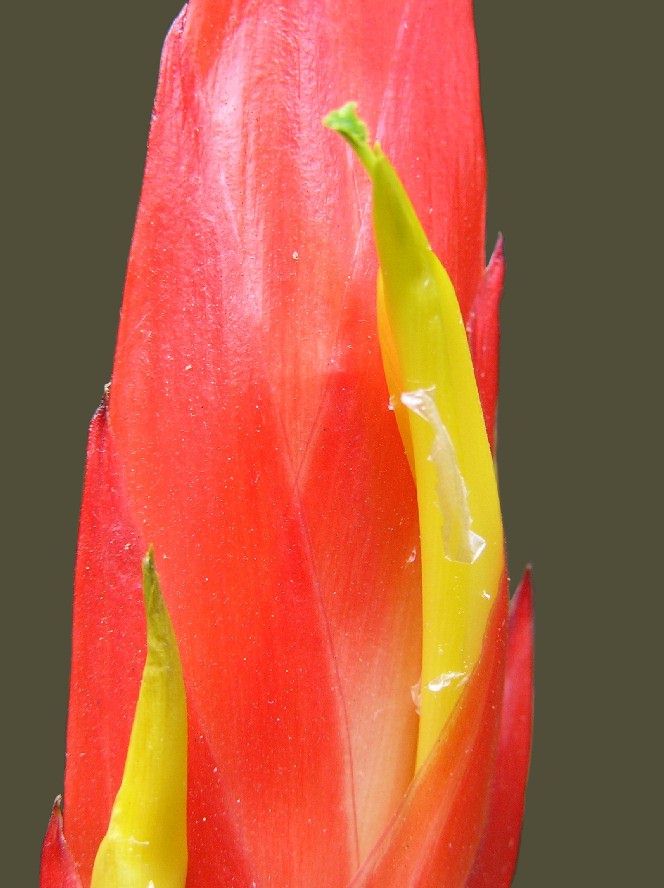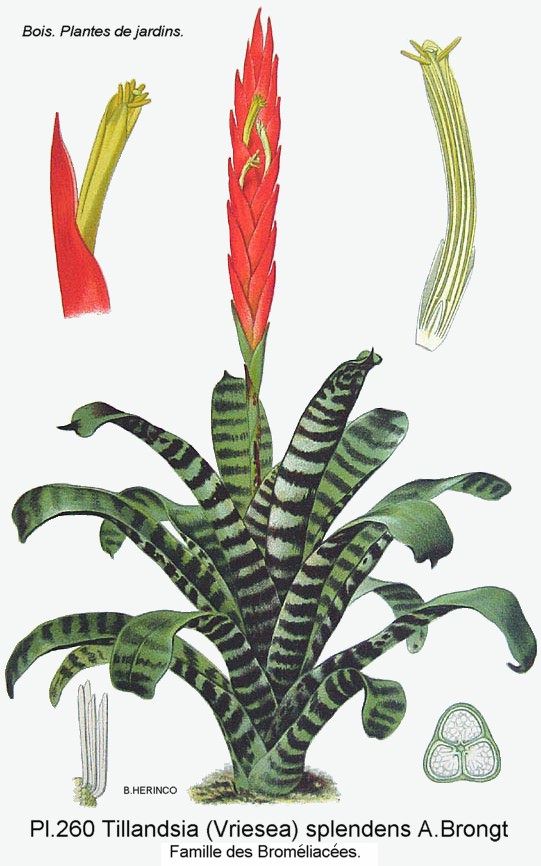




Lutheria splendens (Brongn.) Barfuss & W. Till, comb. nov. Phytotaxa 279(1): 001-097. 2016
Basionym:—Tillandsia splendens Brongn., Ann. Fl. Pomone, ser. 2. 3: 311, pl. (1845), Lectotype (designated by Smith &Downs, 1977: 1217):—Leprieur s.n. in Paris Hortus s.n. (lecto P, iso K!); Mélinon s.n. in Paris Hortus s.n. (syn P)
= Vriesea splendens (Brongn.) Lem., Fl. Serres Jard. Eur. 6 (Misc.): 162, fig. (1850)
= Vriesea speciosa Hook., Bot. Mag. 74: pl. 4382 (1848), Type:—Kew Hortus s.n. (holo ?K)
From Smith & Downs
Vriesea splendens var splendens
Tillandsia splendens Brongn. Hort. Universel vol. 6: 199 (1845) added Sept 2015 by Gouda
Tillandsia splendens Brongniart, Ann. Fl. Pomone 14: 311.1845.
Vriesea speciosa Hooker, Bot. Mag. 74: pl. 4382. 1848. Type. Kew Hortus s n (n v, typified by plate, evidently a clonotype of Tillandsia splendens).
Tillandsia vittata Richard ex Baker, Handb. Bromel. 215. 1889; nomen.
Tillandsia picta hortus ex Baker, Handb. Bromel. 215. 1889; nomen.
Tillandsia zebrina hortus ex Baker, Handb. Bromel. 215. 1889; nomen, non hortus ex Baker, p. 17.
Vriesea splendens "Major" hortus ex M. B. Foster, Bromel. Soc. Bull. II: 7.1961; nomen; Richter, Bromeliaceen 269, 277. 1962.
Lutheria splendens var. striatifolia (M.B. Foster) Barfuss & W. Till, comb. nov. Phytotaxa 279(1): 001-097. 2016 {All variegations should be treated as type because they cannot be reproduced by seed - Butcher. Note that no others have been found in the wild}
Basionym:—Vriesea splendens var. striatifolia M.B. Foster, Bromeliad Soc. Bull. 5: 92, fig. (1955), Type:—Foster 2808 (holo US)
Lutheria splendens var. formosa (Suringar ex Witte) Barfuss W. & Till, comb. nov. Phytotaxa 279(1): 001-097. 2016
Basionym:—Vriesea splendens var. formosa Suringar ex Witte, Sempervirens 18: 361 (1889), Type:—not indicated
= Tillandsia longibracteata Baker, J. Bot. 26: 81 (1888), Type:—Fendler 2449 (holo K; iso GOET)
= Vriesea longibracteata (Baker) Mez in C. DC., Monogr. phan. 9: 568 (Jan 1896)
= Vriesea splendens var. longibracteata (Baker) L.B. Sm., Smisthsonian Misc. Collect. 126: 36 (1955)
= Tillandsia appuniana Baker, Handb. Bromel.: 213 (17 Aug–15 Oct 1889), Type:—Appun s.n. (holo BM)
Detail from Smith & Downs
Vriesea splendens var formosa Suringar ex Witte, Sempervirens, Geillustr. Weekbl. Tuinb. Nederl. 18: 361. 1889.
Tillandsia longibracteata Baker, Jour. Bot. London 26: 81. 1888. Type. Colonia Tovar, Aragua, Venezuela, Fendler 2449 (GOET, K).
Tillandsia appuniana Baker, Handb. Bromel. 213. 1889. Type. Kaieteur Falls, Essequibo, Guyana, Appun s n (BM, GH photo), 1872.
Tillandsia splendens var formosa Suringar ex Witte, Sempervirens, Geillustr. Weekbl. Tuinb. Nederl. 18: 361. 1889; nomen.
Vriesea longibracteata (Baker) Mez, DC. Monogr. Phan. 9: 568. 1896.
Vriesea splendens major Duval Hortus, Revue Hort. 69: 307. 1897; nomen. (! Mez).
Vriesea splendens wardelii hortus, Revue Hort. 70: 246. 1898; nomen. (! Mez).
Vriesea splendens var longibracteata (Baker) L. B. Smith, Smithson. Misc. Collect. 126: 36. 1955.
Lutheria splendens var. chlorostachya (Oliva-Esteve) Barfuss & W. Till, comb. nov. Phytotaxa 279(1): 001-097. 2016
Basionym:—Vriesea splendens var. chlorostachya Oliva-Esteve, J. Bromeliad Soc. 56(5): 199, fig. 1 (Dec 2006), Type:—Oliva-Esteve 304 (holo VEN)
= Vriesea splendens var. chlorostychya Oliva-Esteve, J. Bromeliad Soc. 51(4): 184, figs. 23, 24 (2001), nom. inval. {Art. 40.1}
Lutheria splendens var. oinochroma (Steyerm.) Barfuss & W. Till, comb. nov. Phytotaxa 279(1): 001-097. 2016
Basionym:—Vriesea splendens var. oinochroma Steyerm., Bromeliad Soc. Bull. 17: 53 (1967), Type:—Steyermark 95320 (holo VEN; iso US!)
With such a splendid plant there are cultivars (infra-specific crossings) to consider such as:
Article in French by Louis Dutrie in 1946 by Tom Lineham in English from J Brom Soc 38(4): 169-170. 1988
The series of V. splendens constitutes the aristocracy of the genus.
• V. splendens Brongniart, French Guiana. A very beautiful species with upright leaves, then curved outward, leathery, ornamented on both sides with blackish brown bands, regularly spaced on a green background. The inflorescence is an ensiform, flattened spike 40 cm long, with bracts of a magnificent scarlet.
• V. splendens major Hort. This is the same plant, but much stronger in all its parts. However, the transverse bands are of a brown, less dark and less sharply defined than the type. Occasionally among some specimens it may be observed that on the underside of the leaves the space between the bands is tinged with brown. The floral stem attains a length of 80 cm and bears a spike larger than that of the type, but of the same scarlet color.
• V. splendens mortfontanensis Hort. Chantrier. ( Butcher’s comment – this is now known as ‘Mortfontanensis Splendens’)The plant is of a size intermediate between the two preceding plants, with leaves more upright, and with black-brown bands. The inflorescence attains a length of 60-70 cm, but the spike is not larger than that of V. splendens. The color of the bracts is perhaps a little darker.
• V. splendens chantrieri. This superb plant appeared for the first time at the 1939 Floralies in Belgium. Presented by its originator, M. J. Chantrier of Mortefontaine, it was awarded the prize for new plants. It is of a size at least as well developed as that of V. splendens major, with the coloration of the foliage of V. splendens, and has an inflorescence of 90 cm in length, a spike broader than that of V. splendens major and of a more beautiful scarlet. It is probably a hybrid of these first two, a superb addition.
Sometimes, in batches of V. splendens major one comes across those in which the inflorescence carries two or three branches. It is unfortunate that these, when poorly developed, present a poor appearance. They may occur too high or too low on the floral stem, and be too erect, giving the appearance of being stuck onto the principal spike so that the inflorescence gains nothing in beauty but even loses in elegance. It is, however, probable that this tendency towards branching will bring forth someday a branched inflorescence that is well formed and more elegant.
One peculiarity to point out in V. splendens major, and, more characteristic still in V. splendens chantrieri, is that the offsets are formed at the time of flowering and remain attached to the base of the flowering plant the following year. For this reason it is possible to obtain a year after the first a second flowering giving simultaneously, according to the number of offsets, two or three flowers in this way forming quite remarkable specimens. Let us note that with other vrieseas the flowering of the offsets occurs only after two or three years.’
We now move to what is currently in the BCR (Bromeliad Cultivar Register)
Cayenne (No photo held)
Chantrieri
Fascination (No photo held)
Favoriet
Favourite Yellow
Fire
Flammendes Schwert
Formosa (No photo held)
Hera
Illustris (No photo held)
Juno
Major (No photo held)
Meyer’s Favorite
Nigra (No photo held)
Splenriet
Tepuy (No photo held)
Trinidad (No photo held)
There ae no doubt other names that have not yet been registered in the BCR including ’Era’ and ‘Espada’
Most of these seem to have originated in large commercial nurseries rather than the ‘backyard’ collection. I wonder how these can be seen to be different except with clone crossed clone you would get some sort of hybrid vigour. Some of the registered cultivars were selected from collections made in the wild. What surprises me is that no mutation/sporting to variegation have been reported. Surely this must have happened but in too small a number to be commercially viable. The only reason I can think of is that this species is an upper pupper with offsets being time consuming to extract.
I also wonder how many of the older cultivars survive today and how many lost their label only to be renamed splendens. I hope that all have the typical yellow petals.
So, the name Lutheria splendens var striatifolia will disappear and we wait for someone to grow on a variegated form of any of the above names so that it is stable and in sufficient numbers to be worthy of being called ‘in cultivation’. We may even see another registered name.